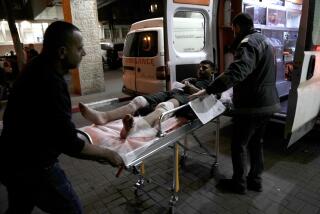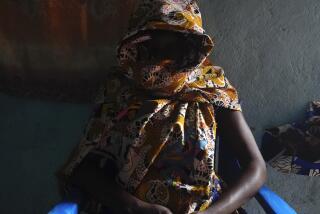Indonesia’s Separatist War Claims the Young
COT RABO, Indonesia — The troops arrived before dawn, moving through the rice paddies and past the shrimp ponds of this quiet coastal village.
The soldiers were hunting for rebels fighting for the independence of Aceh, Indonesia’s westernmost province. What they found, villagers say, were seven boys and men whose job was to watch over the ponds.
What happened next is not entirely clear, but within minutes all seven were dead. One villager says the soldiers shot some of the men and boys as they were trying to escape, and executed others. One of the boys was 12. Another was 13.
“The soldiers say they protect the people, but the fact is they beat me and killed my son,” said another resident, Ajo, the father of Anas Rihan, the youngest victim.
Across this war-torn province, residents say the killing of noncombatants has occurred almost daily since the Indonesian government declared martial law May 19 and launched a major military offensive. This week, The Times visited five villages in the Bireun district of Aceh, where witnesses, neighbors and relatives said Indonesian soldiers had summarily executed 12 people, including the seven in Cot Rabo.
Villagers say all 12 victims were civilians. The government says they were rebels or -- in the case of the children -- rebel spies.
Most of the victims were shot in the head or chest at close range, some after they were severely beaten, said witnesses who saw the bodies. Some corpses were dumped into paddies. Other victims were left where they were slain.
Indonesia says it wants to win the hearts and minds of Aceh’s 4 million people with a campaign that combines military action and humanitarian aid, but the army’s tactics appear to be doing more to create sympathy for the rebels.
“If this happens again and again, it will never solve the problem,” said Yusny Saby, professor of Islamic thought at Ar-Raniry Islamic State University in Banda Aceh, the provincial capital. “It will prolong the hatred and enmity of the people.”
The guerrillas of the Free Aceh Movement have fought for nearly 27 years to win independence for the province, which lies on the northern tip of Sumatra. They say the territory, which is rich in natural gas, was never legally incorporated into Indonesia. The war has claimed more than 10,000 lives, many of them civilian.
The government fears that granting Aceh independence would lead to the breakup of Indonesia, the world’s fourth-most-populous country, where ethnic and religious fighting has erupted repeatedly over the last five years.
Indonesia mounted a brutal campaign in Aceh during the 1990s to crush the independence movement, but it has never been able to defeat the rebels, who hide in the jungle or melt into the civilian population.
The military has been accused of widespread human rights violations, including killings and abductions, but no one has been held accountable, fueling further hatred of the government. People who said they witnessed the recent killings said they feared for their lives and would not give more than a nickname.
The idea of independence has broad appeal in the province, where the government is widely viewed as corrupt. Much of Aceh’s petroleum wealth goes to the government, while military commanders allegedly profit from illegal logging and other illicit enterprises.
Other nations, including the United States, support Indonesia’s right to defend its territorial integrity but have urged both sides to find a peaceful solution.
In December, the Geneva-based Henry Dunant Center mediated a cease-fire that called for the rebels to disarm and for the troops to withdraw to their barracks. The accord brought the province its first period of peace in decades, but the calm evaporated in May.
Most of the fighting since martial law was imposed has taken place in rural areas, where the Free Aceh Movement is strongest.
Charred hulks of trucks and buses sit alongside the main road that runs across the northern tip of Sumatra. Power poles apparently downed by the rebels occasionally block side roads leading to villages. Soldiers and police are deployed at numerous checkpoints. Armored personnel carriers speed along the highway. Troops accompany convoys of 40 trucks or more bringing supplies to the region.
In many towns and villages, the remains of schools destroyed by arsonists are evidence of some of the most senseless destruction of the war. Authorities say nearly 400 schools were torched during the first 10 days of martial law. Each side blames the other.
The military is seeking to hunt down and eliminate an estimated 5,000 rebel fighters. So far, it says it has killed 86. But the soldiers seem to be hampered by a lack of information about the identity and location of the guerrillas.
The military says it will soon begin forcibly relocating some villagers to detention centers to deprive guerrillas of the ability to blend in with civilians. For now, troops are going village to village to question residents.
Dozens of soldiers arrived Sunday morning in the village of Garut while the men were gathered in the mosque discussing local security. Residents say the military had asked them to hold the meeting.
The soldiers surrounded the mosque and ordered the villagers outside, according to three of the men. The soldiers began kicking and hitting some of them and asking where the rebels were, the men said.
According to these accounts, the soldiers dragged two men, sand miners Dulhelmi Cut Hasan, 23, and Ridwan Abdullah, 35, a few yards to the mosque volleyball court, where they once played on the same team. The soldiers accused the two of being rebels and beat them severely, breaking Abdullah’s leg. The soldiers then ordered four men to carry the injured pair to a spot 100 feet down the road, told the men to run -- and shot Abdullah and Hasan in the head.
It is an Acehnese custom to cleanse a site where blood is spilled by starting a small fire. Ashes were evident on the volleyball court and at the roadside where witnesses said the men were killed.
Another member of the volleyball team who said he had helped carry Abdullah to his death said he had not been able to sleep since. “My eyes were closed, but my heart was not,” he said. “I was still remembering what happened.”
Residents of Ara Bungong, the next village up the road, told a similar story: The same morning, troops arrived while the men were in the mosque. The soldiers ordered them outside and began beating and kicking them. One man, Mohammed Hussein, 40, was picked out and beaten so severely that his left eye was dislodged.
The soldiers carried Hussein, a father of six, two blocks away. The villagers heard four shots and later found Hussein’s body. He had been shot in the head. His brains were spilled on the ground, at a spot now covered with ashes.
After the killing, residents said, the soldiers went from house to house, taking money and ordering women and girls to take off their clothes. Villagers said soldiers fondled at least three young women and girls, including one who was 12.
“My heart was beating so fast because I was afraid he would shoot me,” said one 18-year-old woman who said she had been molested. “I’m very scared. I’m afraid they will come back and do the same thing to me.”
On Tuesday, troops from Battalion 144 visited the village of Lawang, where residents told of more mayhem: Most of the men ran into the jungle, but the soldiers caught a dozen and beat them in the roadway with pieces of wood the size of 2-by-4s.
Cocoa farmer Abu Bakar Bin, 35, was barely conscious after he was struck in the head, villagers said. The soldiers took him behind his rough wooden house and shot him in the chest, they said.
“The soldiers should only beat up and kill people who are guilty, not us civilians who are just trying to make a living,” said a villager who gave his name as Hengki.
In Banda Aceh, Indonesian army spokesman Col. Ditya Soedarsono denied that soldiers had intentionally killed civilians in any of the villages and said the military would investigate any complaints lodged by residents.
Soedarsono suggested that guerrillas had staged the attacks wearing uniforms taken from dead soldiers to make it appear that the army was killing civilians. However, the army says that only nine of its soldiers have been killed in the recent fighting and that the bodies had been recovered.
The alleged killing of children May 21 in Cot Rabo remains the most disturbing of the recent accounts. When the troops came, a villager who gave his name as Nas said he was watching over another shrimp pond. He said he saw the soldiers catch five people, including the two boys -- Anas, who would have turned 13 next month, and his friend Dedi Muhammad Daud, who turned 13 in April.
Nas said the soldiers told the five to run, then shot them. Two others were shot at a distance, he said. Villagers said the victims included a boy who was 15, another who was 17 and two men who were 18. The oldest was 22.
The same morning, soldiers sweeping the neighboring village of Pulo Naleng saw 13-year-old Tasran Dahlan run from the ponds and chased him to his house, Nas said. The soldiers caught the boy, took him to the rice paddies and killed him, he said. Tasran’s family declined to be interviewed.
“The military wants to tell the world they were rebels, but in fact they were children,” Nas said. “They were not rebels.”
Anas’ father, Ajo, said he heard the shooting near the ponds. Soon after, the soldiers came searching the houses in the village. Soldiers pointed a gun at his face, he said, and demanded to know where the rebels were hiding. When he told them he didn’t know, they beat him, he said. As they left, they told him someone should pick up the “dead rats” in the rice paddies. He didn’t know they were talking about his son.
Today, Indonesia’s red-and-white flag flies in front of nearly every home in Cot Rabo, Pulo Naleng and the other villages where killings have occurred. The military ordered residents to fly the colors or be accused of disloyalty.
“Flying the flag is an indication of whether they are really Indonesian or not,” said Soedarsono, the military spokesman.
Even the home of 12-year-old Anas has a new red-and-white flag.
“What else can I do?” asked Ajo. “I’m just a poor man.”
More to Read
Sign up for Essential California
The most important California stories and recommendations in your inbox every morning.
You may occasionally receive promotional content from the Los Angeles Times.










